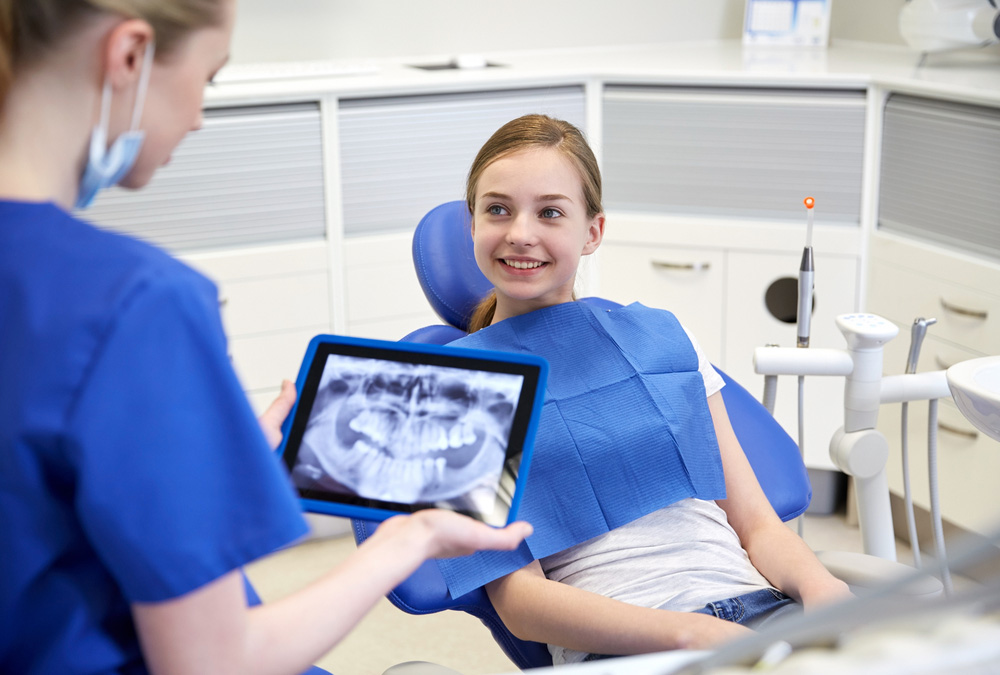
Even though the Earth is bathed in radiation and we’re exposed to it from so many different sources, many of them naturally occurring, the word “radiation” still sets off alarm bells in a lot of people. That’s why patients and parents often ask the Richard Chan Orthodontics team, “Are dental x-rays safe for me?” or “Are dental x-rays safe for my kids?” Rest assured, we’d never put our patients’ health at risk and dental x-rays, especially the low-dose, modern version we use, account for a miniscule fraction of the radiation that’s all around us. They’re not only safe but also an integral part of the diagnostic process, allowing us to give you the best possible care and achieve exceptional results. Unfortunately, in spite of all of the research illustrating the safety of x-rays, misinformation is floating around. To give you peace of mind, we’ll debunk the common dental x-ray myths.
MYTH: Dental X-Rays Emit a Large Dose of Radiation
FACT: We’re all exposed to radiation every single day from both man-made (i.e., x-rays, televisions, road construction materials, smoke detectors, etc.) and natural background sources, which include the sun and stars, internal radiation in our own bodies and the Earth itself thanks to soil and rock, the radon that’s in pretty much all air, water and organic matter, our food included. Millisieverts are a common measurement for the amount of radiation people absorb. The average yearly dose of radiation from all sources for people in the United States is 6.2 millisieverts. This amount isn’t harmful to humans.
About half of that yearly dose is due to man-made sources while the other half is from natural background sources. Your typical intraoral x-ray is .005 millisieverts and your average dental panoramic x-ray is .01 millisieverts. As you can see, it’s just a blip in your overall radiation exposure. Low-dose digital x-rays can actually emit up to 80% less radiation than standard x-rays making their contribution even tinier. To keep it in perspective, since you probably don’t usually throw the term millisieverts around, you’d be exposed to about .510 millisieverts per year of cosmic radiation just from living in Denver, Colorado, which is significantly more than a dental x-ray. You’d receive the same amount of radiation (.01millisieverts) as a dental x-ray by taking a two-and-a-half hour airplane flight.
Book a Free Consultation with our Orthodontist Today!
All of that technical speak isn’t to convince you to run around getting x-ray after x-ray. Most radiation is unavoidable, so limiting it where you can is important. As an orthodontist, Dr. Chan follows the ALARA principle, which stands for “As Low as Reasonably Achievable.” This entails keeping doses of radiation well below the allowable limits for both patients and team members and ensuring the benefits outweigh the x-ray risks before taking them. We typically do a couple types of x-rays at your first appointment to get a full picture of your teeth and jaws for diagnostic purposes. We don’t repeat the x-rays unless it’s truly in your best interest.
You might be wondering if x-rays are so safe then why do medical professionals leave the room? As a patient, you’re only undergoing a single x-ray session, which is perfectly fine and accounts for that tiny portion of your overall exposure. The team members at the dentist or orthodontist’s office are taking numerous x-rays on a daily basis and that adds up. Radiation exposure has a cumulative effect and while what you receive in your day-to-day life, including from x-rays, won’t have an effect on your health, excessive radiation does carry more serious risks
MYTH: Dental X-Rays Cause Cancer
FACT: The risk of cancer from dental x-rays is negligible. While excessive exposure to radiation certainly can cause cancer, as we noted before, taking a short flight will result in the same amount of radiation exposure as a dental x-ray. Since we use low-dose digital x-rays at Richard Chan Orthodontics, you’re getting a lot less radiation than you would with the older bitewing versions, lowering the risk even further. Plus, we employ all of the proper safety measures, such as following the ALARA principle and using shielding.
MYTH: Dental X-Rays are More Dangerous Than Other X-Rays Because They’re Extremely Close to the Brain
FACT: Dental x-rays are ultra-targeted and are capturing an image of a very small area of your body so you get a considerably smaller dose of radiation than you would with say a chest x-ray, which looks at a much larger portion of your body. In fact, dental x-rays emit less radiation than almost any other type of x-ray. While all x-rays are considered safe, if you’re going by radiation level, technically, dental x-rays would actually be preferable. Additionally, the cancer risk associated with radiation is based on your overall cumulative exposure and not necessarily the area of the body that’s being x-rayed.
MYTH: Dental X-Rays are Harmful to Children
FACT: Dental x-rays won’t harm kids. However, children are smaller than adults and still growing and therefore the amount of radiation they’re exposed to should be less than that of grown-ups. This is why we take every precaution possible, including using kid-friendly, low-dose x-rays and only utilizing them when necessary and not as a matter of routine. The American Dental Association, in partnership with more than 80 other healthcare organizations, promotes the Image Gently initiative. The campaign aims to minimize the already extremely small amount of risk by setting forth guidelines to “child-size” radiographic examinations for little ones. Dr. Chan abides by the guidelines, which include investing in the most up-to-date imaging technology, limiting exposure time and using thyroid collars.
MYTH: Dental X-Rays Aren’t Safe for Nursing Mothers
FACT: Nursing mothers don’t need to worry. Radiation from dental x-rays is only present while the actual x-ray is being taken and doesn’t linger in the body or breast milk. You won’t expose your baby to radiation and you don’t need to take any special precautions.
MYTH: Dental X-Rays Aren’t Really Necessary and Just Allow Doctors to Charge More
FACT: Dental x-rays are necessary for detecting tooth decay, gum disease, the position of teeth under the gum line and bone conditions. However, contrary to what some people think, you don’t need them done every year if you have good oral health and no signs of decay or oral disease. Orthodontic x-rays are the same as dental x-rays except we tend to need a broader view as opposed to getting up close and personal with individual teeth. We use x-rays to determine things such as the shape, size, and position of your teeth and jawbone and any underlying conditions that may need to be fixed prior to braces or Invisalign. This important diagnostic information is used to develop a treatment plan that will work for your unique smile needs and produce stable results. If we do happen to uncover problems that aren’t part of the orthodontic scope, like abscesses and tumors, we can refer you to a specialist.
We’re committed to the safety of our Alaska and Bothell, Monroe and Mill Creek Invisalign and braces patients at Richard Chan Orthodontics. Our state-of-the-art equipment ensures we can get the most detailed, precise images with the least amount of radiation possible. If you still have concerns, please, ask away! We’ll address your worries and walk you through the entire process so your main focus can be on achieving a beautiful smile.
